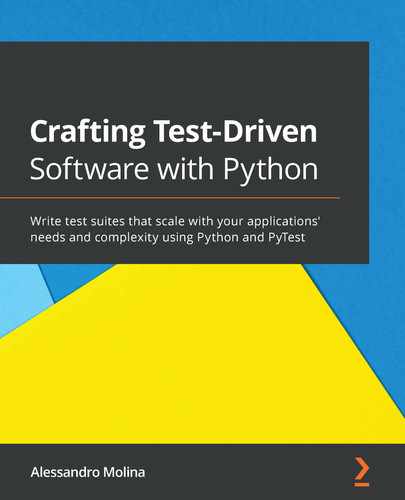Get to grips with essential concepts and step-by-step explanations to apply TDD practices to your Python projects while keeping your test suite under control Test-driven development (TDD) is a set of best practices that helps developers to build more scalable software and is used to increase the robustness of software by using automatic tests. This book shows you how to apply TDD practices effectively in Python projects. You'll begin by learning about built-in unit tests and Mocks before covering rich frameworks like PyTest and web-based libraries such as WebTest and Robot Framework, discovering how Python allows you to embrace all modern testing practices with ease. Moving on, you'll find out how to design tests and balance them with new feature development and learn how to create a complete test suite with PyTest. The book helps you adopt a hands-on approach to implementing TDD and associated methodologies that will have you up and running and make you more productive in no time. With the help of step-by-step explanations of essential concepts and practical examples, you'll explore automatic tests and TDD best practices and get to grips with the methodologies and tools available in Python for creating effective and robust applications. By the end of this Python book, you will be able to write reliable test suites in Python to ensure the long-term resilience of your application using the range of libraries offered by Python for testing and development. This book is for Python developers looking to get started with test-driven development and developers who want to learn about the testing tools available in Python. Developers who want to create web applications with Python and plan to implement TDD methodology with PyTest will find this book useful. Basic knowledge of Python programming is required.Key Features
Book Description
What you will learn
Who this book is for
Table of Contents
- Title Page
- Copyright and Credits
- Dedication
- Contributors
- Preface
- Section 1: Software Testing and Test-Driven Development
- Getting Started with Software Testing
- Technical requirements
- Introducing software testing and quality control
- Test plans
- Introducing automatic tests and test suites
- Multiple test cases
- Organizing tests
- Introducing test-driven development and unit tests
- Test-driven development
- Test units
- Understanding integration and functional tests
- Integration tests
- Functional tests
- Understanding the testing pyramid and trophy
- The testing pyramid
- The testing trophy
- Testing distribution and coverage
- Summary
- Test Doubles with a Chat Application
- Technical requirements
- Introducing test doubles
- Starting our chat application with TDD
- Using dummy objects
- Replacing components with stubs
- Checking behaviors with spies
- Using mocks
- Replacing dependencies with fakes
- Understanding acceptance tests and doubles
- Managing dependencies with dependency injection
- Using dependency injection frameworks
- Summary
- Test-Driven Development while Creating a TODO List
- Scaling the Test Suite
- Section 2: PyTest for Python Testing
- Introduction to PyTest
- Dynamic and Parametric Tests and Fixtures
- Fitness Function with a Contact Book Application
- Technical requirements
- Writing acceptance tests
- Writing the first test
- Getting feedback from the product team
- Making the test pass
- Using behavior-driven development
- Defining a feature file
- Declaring the scenario
- Running the scenario test
- Further setup with the And step
- Performing actions with the When step
- Assessing conditions with the Then step
- Making the scenario pass
- Embracing specifications by example
- Summary
- PyTest Essential Plugins
- Managing Test Environments with Tox
- Testing Documentation and Property-Based Testing
- Section 3: Testing for the Web
- Testing for the Web: WSGI versus HTTP
- End-to-End Testing with the Robot Framework
- About Packt
- Other Books You May Enjoy
